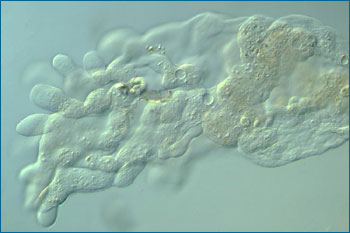by the Understanding Evolution team
In 1966, microbiologist Kwang Jeon was studying single-celled organisms called amoebae, when his amoebae communities were struck by an unexpected plague: a bacterial infection. Literally thousands of the tiny invaders — named x-bacteria by Jeon — squeezed inside each amoeba cell, causing the cell to become dangerously sick. Only a few amoebae survived the epidemic.

However, several months later, the few surviving amoebae and their descendants seemed to be unexpectedly healthy. Had the amoebae finally managed to fight off the x-bacterial infection? Jeon and his colleagues were surprised to find that the answer was no — the x-bacteria were still thriving inside their amoebae hosts, but they no longer made the amoebae sick. There were more surprises when Jeon used antibiotics to kill the bacteria inside an amoeba — the host amoeba also died! The amoebae could no longer live without their former attackers. Jeon discovered that this was because the bacteria make a protein that the amoebae need to survive. The nature of the relationship between the two species had changed entirely: from attack and defense to cooperation.
- What is endosymbiosis?
- What role did endosymbiosis play in the evolution of eukaryotes?
- How does endosymbiosis change our view of the branching pattern on the tree of life?
